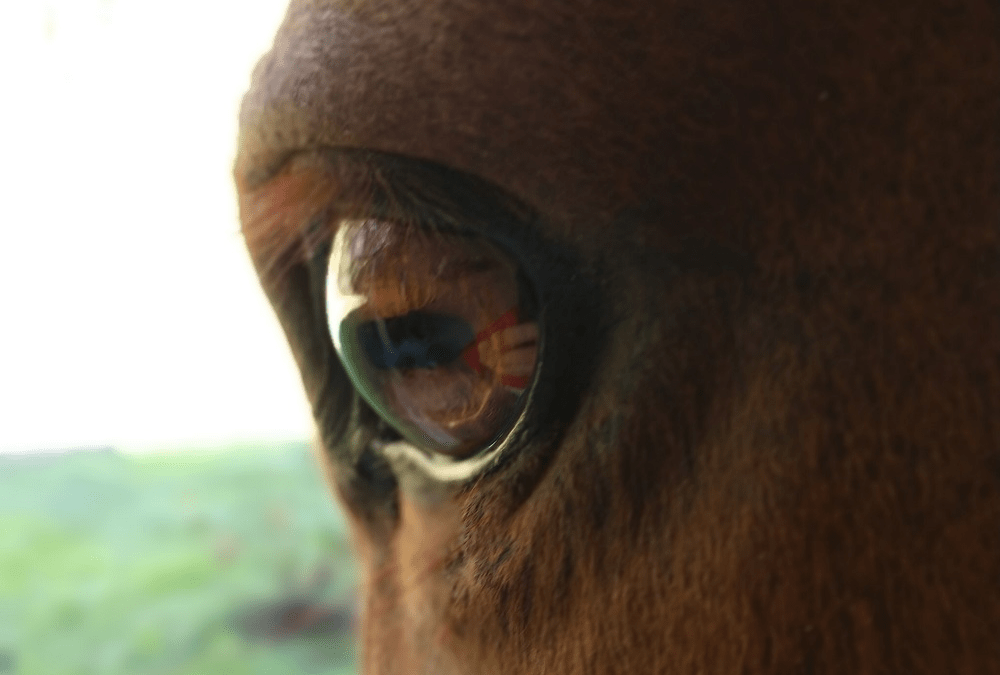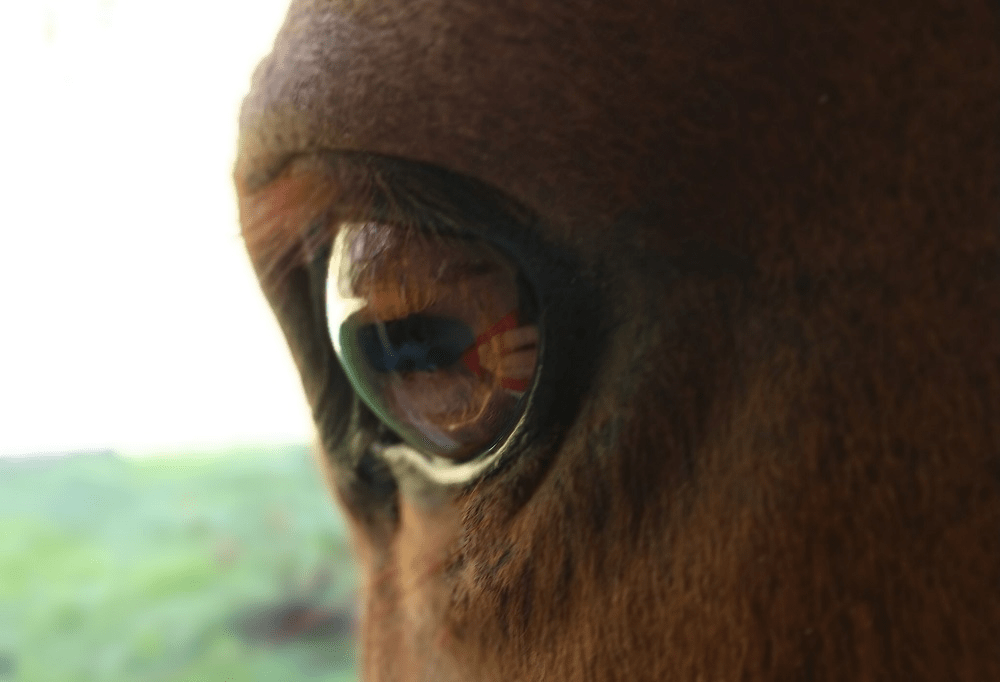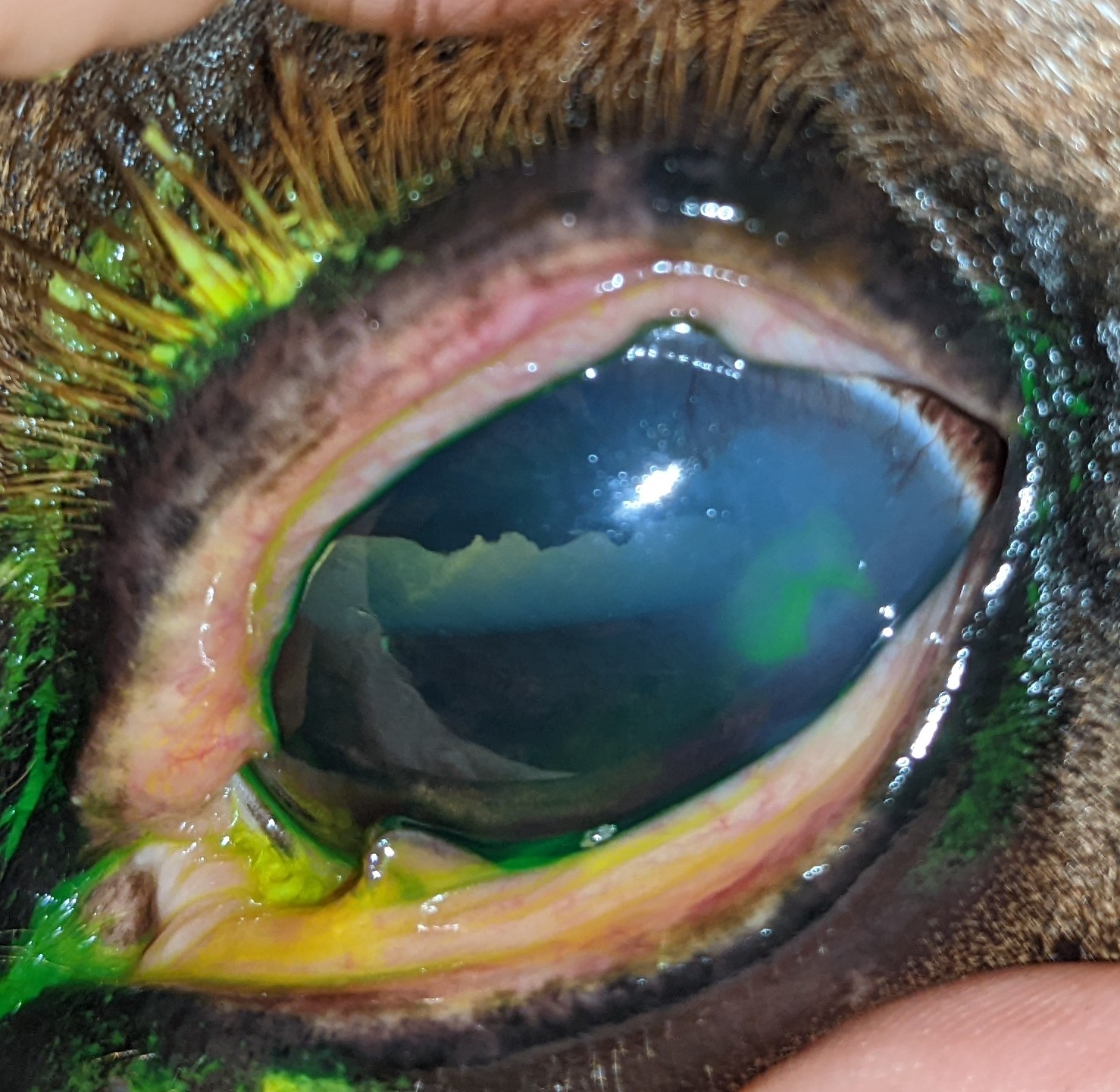
Eye Problems Part 1
Tuesdays with Tony
“Granny, what big eyes you have!”
“All the better to see you with, my dear!”
This doesn’t just apply to wolves and Little Red Riding Hood. Typical of prey animals, horses have giant doe eyes that sit toward the side of their heads and protrude out into the environment. Along with nearly wrap-around vision, having wideset eyes makes horses more prone to eye injuries. As you all know, eye injuries are always an emergency, and you should always call your veterinarian at the first sign of an eye problem.

Given the importance of eyes and the numerous illness and injuries that can affect the eye, this will be a two-part blog. This week we’ll discuss Uveitis and Ulcers, and you’ll have to tune in next week to see what we’ll talk about then. That’s me building antici-purr-tion. And that’s a cat joke.
Uveitis
Equine Recurrent Uveitis, otherwise known as ERU, is a disease of the eye that can affect any horse of any age, breed, or gender. That being said, there are certain breeds that are more prone to ERU, like Appaloosas. Let’s break down each word of Equine Recurrent Uveitis. Equine, that one is simple, equine means horse. Recurrent, means occurring often or repeatedly. Finally, Uveitis, that one is a little more complicated. Uveitis basically means inflammation of the eye. More specifically, it’s inflammation of the layer of the eye that lies between the retina and the sclera and cornea which includes that iris, ciliary body and choroid. So ERU is inflammation of a horse’s eye that occurs frequently.
Signs of ERU are often very subtle. They can range from mild, clear discharge from the eye to thick mucoid discharge. There may also be occasional swelling of the conjunctiva and eyelids. More obvious symptoms can range from cloudiness of the eye to squinting. As you can imagine, with chronic inflammation come other underlying problems. Frequent inflammation results in the development of scar tissue which can affect the lens of the eye leading to cataract development and blindness. Similarly, uveitis can result in decreased drainage of the fluid within the eye which can cause an increase in ocular pressure. As the pressure increases, glaucoma develops and blindness occurs, and you can imagine the headache your poor horse must have. This stuff is painful!
Prevention and treatment of uveitis flare-ups are key. Unfortunately, there is no cure for ERU and long-term prognosis is guarded. Prevention is difficult but keeping your horse in a UV-resistant fly mask is your best tool. Catching symptoms early can help reduce the effects and control the pain. Systemic anti-inflammatories including bute and banamine can help during a flare up. However, topical application medications including steroids such as dexamethasone, topical atropine and/or topical non-steroidal anti-inflammatories including diclofenac reduce inflammation and minimize damage. Surgical implantation of a cyclosporine implant slowly releases the immunosuppressant for up to 3 years and reduces the occurrence and severity of ERU.
As I mentioned earlier, end-stage uveitis can result in cataracts and glaucoma, ultimately causing blindness. It can also result in shrinkage of the eye to the point of complete loss of the eye. Treatment of an end-stage uveitic eye is a salvage procedure and includes injection of medications including the antibiotic gentamicin or the steroid triamcinolone into the globe. The result of such injections kills the eye, causes complete blindness but also reduces the pain associated with ERU. Alternatively, a severely uveitic eye may be a candidate for enucleation where the globe is surgically removed. Either way, the ultimate goal for end-stage uveitis is to alleviate all pain associated with the eye.
Ulcers
Corneal Ulcers are a frequent occurrence in horses. I swear, they must find any bush or tree or shrub and intentionally stick their head directly in it with their eyes wide open. Horses really aren’t the smartest creatures on the planet. The smallest piece of sand or tiny little branch can wreak havoc on horse’s eyes, and a small abrasion on the eye can result in a defect of the cornea and a corneal ulcer. Corneal ulcers can range from superficial to deep and even can risk perforating the eye completely. A perforated eye can be disastrous for both horse and owner.

Corneal ulcers can present similarly to uveitis. You may notice tearing, swelling, and squinting. If you ever notice any of these signs, it is your cue to call your veterinarian. Do not pass go, do not collect $200, just call your vet. An ulcer that is treated quickly and effectively can heal within days. Left untreated, a corneal ulcer can become a melting ulcer, or worse, can perforate the eye within days. Once diagnosed with an ulcer, your veterinarian will prescribe a very specific treatment regime that can range from 2-3 times a day medications to every 2 hours medications, depending on the severity of the ulcer. Trust me, they do not prescribe every 2 hours medications just for fun. They know exactly how much effort it takes but they also know that if you follow their instructions, it is very likely that the ulcer will heal and your horse will have a functional, seeing eye.
Occasionally, treatment may require the insertion of a subpalpebral lavage. A subpalpebral lavage, or SPL, is a system made up of tubing that is placed through your horse’s upper or lower eyelid and held in place by a footplate that rests inside the eyelid along the conjunctiva. The tubing is then weaved through your horse’s mane and a catheter with an injection cap is secured to the end. This system allows for easy medication administration directly to the eye without having to manipulate the eye itself. SPLs are reserved for severe cases which require frequent administration of numerous medications.
While corneal ulcers can be simple and resolve quickly, they can also cause major problems and lead to long-term dysfunction of the eye. I cannot stress this enough: if you think your horse has a problem with his eyes, call your veterinarian immediately.
Stayed tuned for next week’s Part 2 on eyes.
Until then,
-Tony
P.S. If you can’t wait a week to learn more about eyes, head on over to the Podcast Page and scroll down through the Straight from the Horse Doctor’s Mouth library. There are several episodes on eyes, more than enough to tide you over for a week. There are nearly 100 episodes altogether so far, which is a lot of horse doctor knowledge. That’s nearly as valuable as cat knowledge. Nearly.
Tuesdays with Tony is the official blog of Tony the Clinic Cat at Springhill Equine Veterinary Clinic in Newberry, Florida. If you liked this blog, please subscribe below, and share it with your friends on social media! For more information, please call us at (352) 472-1620, visit our website at SpringhillEquine.com, or follow us on Facebook!
[jetpack_subscription_form title="Subscribe to Whinny's Wisdoms"]

